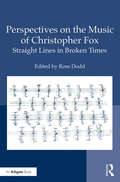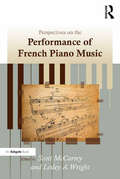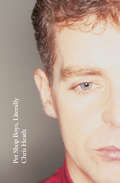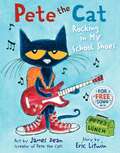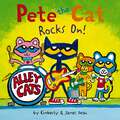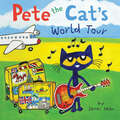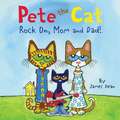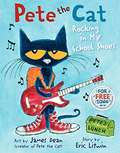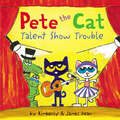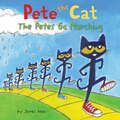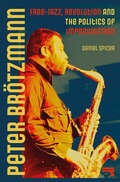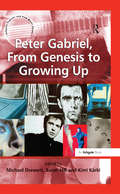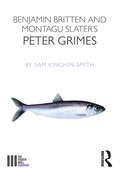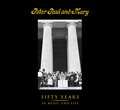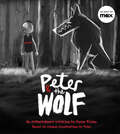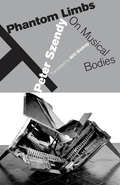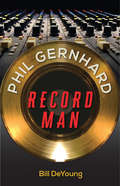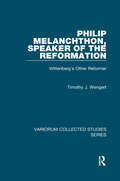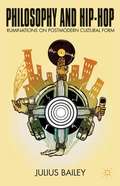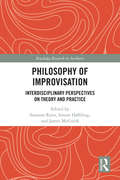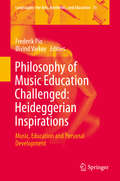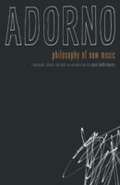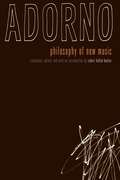- Table View
- List View
Perspectives on the Music of Christopher Fox: Straight Lines in Broken Times
by Rose DoddChristopher Fox (1955) has emerged as one of the most fascinating composers of the post-war generation. His spirit of experimentalism pervades an oeuvre in which he has blithely created his own version of a range of contemporary musical practices. In his work many of the major expressions of European cultural activity - Darmstadt, Fluxus, spectralism, postminimalism and more - are assimilated to produce a voice which is uniquely resonant and multifaceted. In this, the first major study of his work, musicologists, composers, thinkers and practitioners scrutinize aspects of Christopher Fox's music, each exploring elements that relate to their own distinct areas of practice, tracing Fox's compositional trajectory and situating it within post-war contemporary European music practice. Above all this book addresses the question: How can one person dip his fingers into so many paint pots and yet retain a coherent compositional vision? The range of Fox's musical concerns make his work of interest to anyone who wants to study the development of so-called new music spanning the latter twentieth century into the twenty first century.
Perspectives on the Performance of French Piano Music
by Lesley A. WrightPerspectives on the Performance of French Piano Music offers a range of approaches central to the performance of French piano music of the nineteenth and twentieth centuries. The contributors include scholars and active performers who see performance not as an independent activity but as a practice enriched by a wealth of historical and analytical approaches. To underline the usefulness of contextual understanding for performance, each author highlights the choices performers must confront with examples drawn from particular repertoires and composers. Topics explored include editorial practice, the use of early recordings, emergent disciplines such as analysis-and-performance, and traditions passed down from teacher to student. Themes that emerge demonstrate the importance of editions as a form of communication, the challenges of notation, the significance of detail and of deeper continuity, the importance of performing and teaching traditions, and the influence of cross disciplinary frameworks. A link to a set of performed examples on the frenchpianomusic.com website allows readers to hear and compare performances and interpretations of the music discussed. The volume will appeal to musicologists and analysts interested in performance, performers, students, and piano teachers.
Pet Shop Boys versus America
by Chris HeathNo other pop group in recent history has faced fame with such intelligence, humour and shrewdness as the Pet Shop Boys. In 1991, the band toured North America for the first time shadowed by journalist Chris Heath and legendary rock photographer Pennie Smith. They visited fourteen cities in one month, confronting the American music industry and colliding with the likes of Liza Minnelli, Steven Spielberg and Axl Rose. This is more than a documentary of a tour; it is an unusually intimate portrait of two maverick British musicians always reluctant to compromise.‘There was a time when the Pet Shop Boys seemed to exist entirely on radio, television and in magazines. This is the other world of the Pet Shop Boys in concert, travel and backstage, as they bring their art and glamour to America. It’s funny too.’ Johnny Marr‘A brilliant book, to be read over and over again. How could anyone not love these men?’ NME
Pet Shop Boys, Literally
by Chris HeathThe Pet Shop Boys are one of the most successful and unusual bands of the last five decades. They are the pop duo that proves pop music can be modern, ecstatic and playful as well as serious and intelligent, winning them legions of devoted fans throughout the world.In 1989, Neil Tennant and Chris Lowe invited journalist Chris Heath and photographer Lawrence Watson to shadow them around Hong Kong, Japan and the UK as they embarked on their first-ever tour. This book is the result: an immersive portrait giving access into the duo’s inner sanctum, showing them in brilliantly observed detail as they work, relax, gossip, argue and occasionally try to make sense of what they do.‘As clear a picture as could be wished for of the seething mass of elegant contradictions that is the Pet Shop Boys’ on-the-road experience.’ Independent on Sunday‘This superbly reported book transcends tired rock journalism cliché. It’s about what it means to be a pop star, what it means to be a Pet Shop Boy… how to love pop, hold it to a higher standard and subvert its expectations.’ Laura Snapes
Pete the Cat Rocking in My School Shoes: A Back To School Book For Kids (Pete The Cat Ser.)
by Eric LitwinPete the cat wears his school shoes while visiting the library, the lunchroom, the playground, and more while singing his special song.
Pete the Cat Rocks On! (Pete the Cat)
by Kimberly Dean James DeanRock on with Pete the Cat in this groovy storybook about keeping calm and rocking on by New York Times bestselling author-illustrator team Kimberly and James Dean. Includes over thirty stickers!Pete the Cat can’t wait to rock out at the Alley Cats concert! But when the band never comes onstage, it’s up to Pete to find them. Will Pete have the right instruments to help the Alley Cats save the show? Find out in this rockin’ story full of problem-solving and friendship! Includes over thirty awesome stickers.
Pete the Cat's World Tour (Pete the Cat)
by Kimberly Dean James DeanDon't forget your passport...it's Pete the Cat's groovy tour around the world! In Pete the Cat's World Tour, from New York Times bestselling author and illustrator James Dean, Pete the Cat and his band have packed up their bags and are ready to perform all over the globe. But what’s the fun in globe-trotting if you don’t go out exploring?From Mexico to Iceland, Pete and his friends get a taste of what each country has to offer.
Pete the Cat: Rock On, Mom and Dad! (Pete the Cat)
by Kimberly Dean James DeanRock out with Pete the Cat in New York Times bestselling artist James Dean's Pete the Cat: Rock On, Mom and Dad!Mom and Dad do so much for Pete that he wants to thank them with a special surprise. But what can Pete do that will show Mom and Dad how much he loves them?In this groovy story, Pete learns that it’s not what you do but how you do it that matters, so long as it comes from the heart. Young readers will love watching Pete surprise Mom and Dad with something totally awesome.Moms and dads looking for a Mother's Day or Father's Day present for their child to give should consider Rock On, Mom and Dad!
Pete the Cat: Rocking in my School Shoes (Into Reading, Big Book Module 1)
by Eric Litwin James DeanNIMAC-sourced textbook <P><P>Time to head back to school with this bestselling groovy Pete the Cat book! <P><P>Pete the Cat is rocking in his school shoes. Pete discovers the library, the lunch room, the playground, and lots of other cool places at school. And no matter where he goes, Pete never stops moving and grooving and singing his song...because it’s all good. <P><P>The fun never stops—download the free groovin’ song. <P><P>Lexile Measure: AD430L
Pete the Cat: Talent Show Trouble (Pete the Cat)
by Kimberly Dean James DeanRock out with Pete the Cat and Grumpy Toad in this brand-new book from New York Times bestselling author-illustrator team Kimberly and James Dean. Includes over 30 cool stickers!Pete the Cat’s school is hosting a fun talent show! Pete knows just what to sign up for—playing the guitar. But when he writes his name on the list, he is surprised to see Grumpy Toad also signed up for the same talent.Join Pete the Cat and Grumpy Toad as they learn about the importance of teamwork and friendship!
Pete the Cat: The Petes Go Marching (Pete the Cat)
by Kimberly Dean James Dean#1 New York Times bestseller James Dean puts a groovy spin to the classic children’s song “The Ants Go Marching" with everyone's favorite cool cat. Join Pete the Cat as he rocks out to this classic tune with a supercool twist in this paper-over-board picture book.Your child, or even your classroom of children, is sure to want to march along with Pete, 1, 2, 3!
Peter Brötzmann: Free-Jazz, Revolution and the Politics of Improvisation
by Daniel SpicerExplores the heroic life and revolutionary music of the pioneering German saxophonist, and the radical social and political convictions that informed them.Peter Brötzmann is the first ever, full-length, English-language biography of one of the most fascinating and inspiring personalities in the history of Western improvised music – and one of the key artistic figures to emerge from the socio-cultural tumult of the 1960s.Drawing on extensive interviews with Brötzmann and key associates, it traces the German saxophonist&’s crucial role as a pioneer of European free jazz, his restless travels and collaborations and his eventual superstardom, examining the life and work of a fiercely uncompromising artist with a reputation for gruff intensity and total commitment.Digging deep into the history and aesthetics of free jazz in Europe and beyond, it provides detailed analysis of music by Brötzmann and other major figures, while positioning Brötzmann&’s work – and the wider free jazz milieu – in the context of the revolutionary left-wing, humanist and utopian ideals that inspired and underpinned it.Both intimate and wide-ranging, it tells the story of a man and a music that changed the world.
Peter Gabriel, From Genesis to Growing Up (Ashgate Popular And Folk Music Ser.)
by Sarah HillEver since Peter Gabriel fronted progressive rock band Genesis, from the late 1960s until the mid 1970s, journalists and academics alike have noted the importance of Gabriel's contribution to popular music. His influence became especially significant when he embarked on a solo career in the late 1970s. Gabriel secured his place in the annals of popular music history through his poignant recordings, innovative music videos, groundbreaking live performances, the establishment of WOMAD (the World of Music and Dance) and the Real World record label (as a forum for musicians from around the world to be heard, recorded and promoted) and for his political agenda (including links to a variety of political initiatives including the Artists Against Apartheid Project, Amnesty International and the Human Rights Now tour). In addition, Gabriel is known as a sensitive, articulate and critical performer whose music reflects an innate curiosity and deep intellectual commitment. This collection documents and critically explores the most central themes found in Gabriel's work. These are divided into three important conceptual areas arising from Gabriel's activity as a songwriter and recording artist, performer and activist: 'Identity and Representation', 'Politics and Power' and 'Production and Performance'.
Peter Grimes
by Sam Kinchin-Smithã `Who can turn skies back and begin again?' -Peter ã This book contends that Peter Grimes, widely regarded as one of the greatest and most influential operas of the 20th century, is also one of the British theatre's finest `lost' plays. Seeking to liberate Britten and Slater's work from the blinkered traditions of theatre and opera criticism, Sam Kinchin-Smith poses two questions: If an opera was created like a play, and can be staged as a play, is it a play? If a portion of its success and influence is the product of this newly identified theatrical engine, is it then a great play? The answers involve Wagner and W.G. Sebald, George Crabbe and Complicite, Akenfield and Twin Peaks. Challenging long-established narratives of post-war theatre history, this book makes a compelling case for why practitioners and scholars of performance ought to pay more attention to Britten and Slater's achievement - a milestone of unconventional English modernism - and perhaps to other operatic masterpieces too.
Peter Paul and Mary: Fifty Years in Music and Life
by Peter Yarrow Noel Paul Stookey Mary TraversThis carefully crafted and collectible volume tells the intimate story of Peter, Paul, and Mary and their music, in their words and with iconic images that follow their passionate, fifty-year journey to the center of America&’s heart. Photographs, many rare and never before published, taken over five decades by some of the world&’s top photographers, follow them from their earliest performances in the 1960s, when Mary was the most desired, beautiful, and charismatic performer and a new role model for women. Follow the trio as they lead America to discover the passionate soul of folk music. Join the struggle for racial equality, social justice, and freedom in this memorable journey, from the historic 1963 March on Washington with Martin Luther King, Jr., to the trio&’s appearance before a half million people in 1969 to end the Vietnam War, to their singing at the Hollywood Bowl for Survival Sunday in 1978, helping to launch the anti-nuke movement, the world&’s first international environmental movement. Through these images, readers will feel and almost hear the trio&’s songs calling for a more caring, better world as they performed with a courage and conviction that became for so many the embodiment and soundtrack of their generation&’s awakening to conscience, to activism, and to a new dream for all of humankind. Peter, Paul, and Mary&’s songs of defiant hope and a certain unmasked innocence are still a powerful part of our American consciousness, and this book reenacts the history of how the trio marked many lives with their indelible stamp of honesty of the sort we all yearn to recapture and recreate today—for ourselves, our children, and the generations to come.
Peter and the Wolf: Wolves Come in Many Disguises
by Gavin FridayRelive the magic of Peter and the Wolf through this extraordinary modern retelling by award-winning musicians Gavin Friday and Bono. When a wolf is found roaming the woods, Peter&’s grandfather warns him to stay at home. But Peter, who is mourning the loss of a parent, decides to venture into the deep, dark woods in search of this creature…This incredible retelling of the well-loved classic story, Peter and the Wolf takes children aged 7-9 on an adventure while exploring themes of love and loss. With its spellbinding punk rock illustrations, this book is a beautiful reminder that there is hope after loss and those we love most are never truly gone. A timeless and magical gift book, Peter and the Wolf will be treasured by all. This modern retelling of Peter and the Wolf offers:- A dynamic new take on Prokofiev&’s tale about a young boy who captures a wolf, with magical graphic novel-esque illustrations.- An underlying theme of loss, told with sensitivity and warmth, helping children to understand and navigate the topic. - A treasured keepsake book based on a classic story beloved by generations of children and adults, with vivid illustrations and a red ribbon.- An enchanting story written by Gavin Friday and stunning visuals based on Bono&’s original illustrations - with an accompanying animated short film.In Prokofiev&’s original tale, Peter outsmarts the big, bad wolf, capturing him, and parading him victoriously around the town with the hunters. But this is not our ending and nothing is the way it seems…This extraordinary rendition of Peter and the Wolf echoes the message of courage that is so central to the famous classic, while gently introducing themes of loss, grief, and growing up and helping young readers to navigate them.
Phantasmagoria: Sociology of Opera (Routledge Revivals)
by David T. EvansFirst published in 1999, this original and entertaining sociological study takes a comprehensive and critical view of opera as unique cultural artefact as loss making ‘industry’, as institution with a ‘museum’ culture, and as consumed commodity of rare distinction and elaborate ritual. Specific chapters deal with opera within the contexts of musicological analysis, auratic art and fetishized taste: opera as business and as ‘museum’: singers’ opera: producers’ opera and audiences’ opera. There is also a chapter on ‘opera’: popular, commercialised fragments of opera outside the opera house, consumed by and through all manner of reproduced means: CD, video, Three Tenors concerts: film and TV soundtracks: advertising jingles etc. Despite the supposed popularisation and successful commercial exploitation of ‘opera’ during the past decade or so, this study concludes that opera remains an art-form, institution and ritual of relative inaccessibility and exclusiveness. The commercial interest in and profitability of ‘opera’ do not translate into new ‘popular’ audiences in the opera house. The increased dependency of opera companies on corporate funding in the face of retreating government subsidies may have brought a new ‘elite’ audience into the expensive seats, pandered to by the introduction of surtitles etc., but the traditional ‘elite’ has succeeded in closing down entry to opera in other select venues where opera continues to confirm and maintain their select identity and prestige of their life-style.
Phantom Limbs: On Musical Bodies
by Peter SzendyThe prostheses Peter Szendy explores—those peculiar artifacts known as musical instruments—are not only technical devices but also bodies that live a strange phantom life, as uncanny as a sixth finger or a third lung.The musicological impulse to inventory those bodies that produce sound is called into question here. In Szendy’s hands, its respectable corpus of scholarship is read aslant, so as to tease out what it usually prefers to hide: hybrids and grafts produced by active fictions, monsters, and chimera awaiting the opportunity to be embodied. Beyond these singular bodies that music composes and disposes there lies the figure of a collective “social” body ready to emerge amid an innervated apparatus that operates at a distance, telepathically.Phantom Limbs touches on bodies of all shapes and sizes that haunt the edges of music’s conceptualizations. Music continually reinvents such bodies and reconvenes them in new collective formations. It is their dynamics and crystallizations that Szendy auscultates on a motley corpus that includes Bach, Diderot, Berlioz, Eisenstein, Disney, and Monk.
Phil Gernhard, Record Man
by Bill DeYoungA go-getting, red-headed college kid eager to break into the music business, Phil Gernhard produced a handful of singles for South Carolina doo-wop group Maurice Williams and the Zodiacs. One of these songs, "Stay," reached number one on the charts in 1960. Gernhard was just 19 years old. Phil Gernhard, Record Man is the story of a self-made music mogul who created nearly fifty years' worth of chart-topping songs. From a tiny office and studio in Florida, he co-wrote the Royal Guardsmen's "Snoopy vs. the Red Baron," America's fastest-selling single of 1966. He revived the career of singer Dion DiMucci with the ballad "Abraham, Martin and John"--a million seller. He discovered and produced hit records for Lobo, Jim Stafford, and the Bellamy Brothers. Through a long collaboration with music business icon Mike Curb, he launched to fame many others, including country superstars Tim McGraw and Rodney Atkins. In Nashville and Los Angeles, Phil Gernhard was a legend. Yet Gernhard's private life was crumbling. He battled physical and emotional demons that he simply couldn't overcome, struggling with alcoholism, drug addiction, and a bad past with his father. He filed for his fourth divorce just months before taking his own life in 2008. Through interviews with Gernhard's musicians, business partners, family members, and ex-wives, Bill DeYoung offers an intimate portrait of a brilliant yet troubled man who channeled his talent, ego, and ambition into the success of others. A true "record man," Gernhard did it all. He lived to make records into gold, to make unknowns into stars, and above all, to make music.
Philip Melanchthon, Speaker of the Reformation: Wittenberg's Other Reformer (Variorum Collected Studies)
by Timothy J. WengertThe studies in this volume illuminate the thought and life of Philip Melanchthon, one of the most neglected major figures in Reformation history and theology. Melanchthon was one of the most widely published and respected thinkers in his own day, who authored some of the sixteenth-century's most important books on Latin and Greek grammar, rhetoric, dialectics, and history, to say nothing of his theological output, which included the first overview of Protestant theology, the first Protestant commentaries on Romans, 1 & 2 Corinthians, and John. He was also the chief drafter of the Augsburg Confession and wrote its defense, the Apology. These essays, written over the past twenty years, commemorate the 450th anniversary of Melanchthon's death in 2010. The articles provide a wide-ranging picture of Melanchthon's thought and life with topics including his view of free will, approaches to biblical interpretation, his perspective on the church fathers and world history, and comparisons to other important figures of the age, including Calvin, Luther and Erasmus.
Philosophy And Hip-hop
by Julius BaileyPhilosophy and Hip-Hop: Ruminations on Postmodern Cultural Form opens up the philosophical life force that informs the construction of Hip-hop by turning the gaze of the philosopher upon those blind spots that exist within existing scholarship. Traditional Departments of Philosophy will find this book a solid companion in Contemporary Philosophy or Aesthetic Theory. Inside these pages is a project that parallels the themes of existential angst, corporate elitism, social consciousness, male privilege and masculinity. This book illustrates the abundance of philosophical meaning in the textual and graphic elements of Hip-hop, and thus places Hip-hop within the philosophical canon.
Philosophy of Improvisation: Interdisciplinary Perspectives on Theory and Practice (Routledge Research in Aesthetics)
by Susanne Ravn; Simon Høffding; James McGuirkThis volume brings together philosophical and interdisciplinary perspectives on improvisation. The contributions connect the theoretical dimensions of improvisation with different viewpoints on its practice in the arts and the classroom. The chapters address the phenomenon of improvisation in two related ways. On the one hand, they attend to the lived practices of improvisation both within and without the arts in order to explain the phenomenon. They also extend the scope of improvisational practices to include the role of improvisation in habit and in planned action, at both individual and collective levels. Drawing on recent work done in the philosophy of mind, they address questions such as whether improvisation is a single unified phenomenon or whether it entails different senses that can be discerned theoretically and practically. Finally, they ask after the special kind of improvisational expertise which characterizes musicians, dancers, and other practitioners, an expertise marked by the artist’s ability to participate competently in complex situations while deliberately relinquishing control. Philosophy of Improvisation will appeal to anyone with a strong interest in improvisation, to researchers working in philosophy, aesthetics, and pedagogy as well as practitioners involved in different kinds of music, dance, and theater performances.
Philosophy of Music Education Challenged: Heideggerian Inspirations
by Frederik Pio Øivind VarkøyThis volume offers key insights into the crisis of legitimization that music as a subject of arts education seems to be in. Music as an educational subject is under intense pressure, both economically, due to the reduction of education budgets, as well as due to a loss of status with policy makers. The contributions in this book illuminate Martin Heidegger's thinking as a highly cogent theoretical framework for understanding the nature and depth of this crisis. The contributors explore from various angles the relationship between the pressure on music education and the foundations of our technical and rationalized modern society and lead the way on the indispensable first steps towards reconnecting the cultural practices of education with music and its valuable contributions to personal development.
Philosophy of New Music
by Theodor W. Adorno Robert Hullot-KentorIn 1947 Theodor Adorno, one of the seminal European philosophers of the postwar years, announced his return after exile in the United States to a devastated Europe by writing Philosophy of New Music. Every aspect of this work was met with extreme reactions, from stark dismissal to outrage. Despite the controversy, Philosophy of New Music became highly regarded and widely read among musicians, scholars, and social philosophers.
Philosophy of New Music
by Theodor W. AdornoAn indispensable key to Adorno&’s influential oeuvre—now in paperbackIn 1949, Theodor W. Adorno&’s Philosophy of New Music was published, coinciding with the prominent philosopher&’s return to a devastated Europe after his exile in the United States. Intensely polemical from its first publication, every aspect of this work was met with extreme reactions, from stark dismissal to outrage. Even Arnold Schoenberg reviled it. Despite the controversy, Philosophy of New Music became highly regarded and widely read among musicians, scholars, and social philosophers. Marking a major turning point in his musicological philosophy, Adorno located a critique of musical reproduction as internal to composition, rather than a matter of musical performance. Consisting of two distinct essays, &“Schoenberg and Progress&” and &“Stravinsky and Reaction,&” Philosophy of New Music poses the musical extremes in which Adorno perceived the struggle for the cultural future of Europe: between human emancipation and barbarism, between the compositional techniques and achievements of Schoenberg and Stravinsky. In this translation, which is accompanied by an extensive introduction by distinguished translator Robert Hullot-Kentor, Philosophy of New Music emerges as an essential guide to the whole of Adorno's oeuvre.
